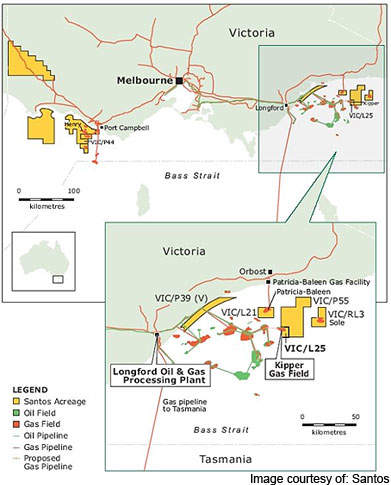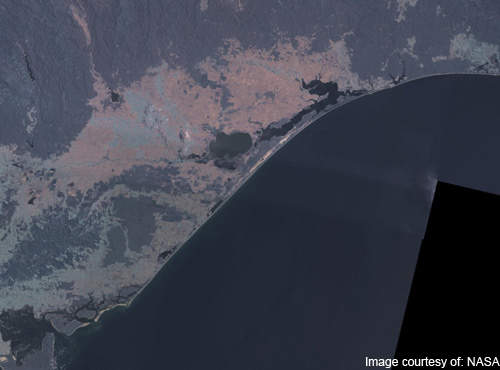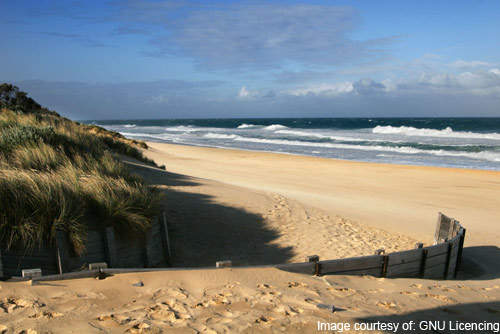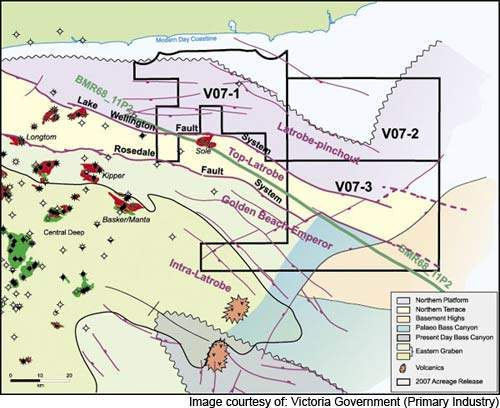The Kipper Gas Field lies in 100m of water, approximately 45km off Ninety Mile Beach, in the Gippsland Basin. In December 2007, the first phase of the planned $A1.4bn project to develop this field – currently Victoria’s largest known undeveloped
gas resource – was given the go-ahead by the Kipper Unit Joint Venture (KUJV) partners. KUJV itself comprises wholly owned subsidiaries of Santos (35.0%) ExxonMobil (32.5%) as operator and BHP Billiton (32.5%).
Since the mid-sixties, with the discovery of the large Marlin gas field and the subsequent discovery in 1967 of Kingfish 1, the largest Australian oil field known to date, the Gippsland Basin has been widely recognised as a prolific zone of
world-class oil and gas reserves.
KIPPER RESERVES
Kipper has a confirmed resource of 620 billion cubic feet of recoverable gas – an estimated 610 Petajoules of sales gas (net of fuel and flare) – together with reserves of recoverable condensate and LPG amounting to some 30 million barrels
of oil equivalent. The field has an estimated 15-year life.
To date, the developed fields in the Gippsland Basin have produced 3.8 billion stock tank barrels of oil and 6.5 trillion cubic feet of gas – representing 90% of the initial oil reserves and nearly 60% of the gas.
GAS FIELD DEVELOPMENT
The Kipper field was first discovered in 1986, when a 213m gas column was intersected in fluvial sandstones of the Golden Beach Subgroup. Production licence VIC/L25 was granted in July 2006 to Esso Australia Resources, BHP Billiton Petroleum
(Victoria) and Santos Offshore, with their decision to begin the initial stage of development following at the end of 2007.
Detailed design and procurement is scheduled to begin during 2008, with offshore construction and installation expected to be underway in 2010, aiming at first gas production by the middle of 2011. Initially the gross gas production rates will be
around 75 terajoules a day – the plan being to double that with the second phase of the development, expected to be implemented around four years later.
Production will be delivered by a number of subsea wells – two to be installed during phase one and a further two in phase two – with the gas being piped back to existing processing infrastructure at Longford. This is separately owned by
the Gippsland Basin Joint Venture (GBJV) – a 50:50 partnership between ExxonMobil Australia as operator and BHP Billiton. Kipper gas will be the first ever third-party-owned production to use the GBJV facility.
Phase one of the project will see initial development of the field, involving the construction and installation of four subsea coolers with tieback to a subsea manifold, three new pipelines and platform modifications, in addition to the two subsea
wells. In phase two – scheduled for 2015 – the additional two subsea wells will be installed and linked in to the existing infrastructure to raise the total gas production rate to around 150 terajoules a day. Implementing these aspects of the
project falls in its entirety to KUJV.
Connecting the Kipper installation to the existing GBJV-owned infrastructure and processing facilities will be the subject of separate works, which will be the responsibility of GBJV themselves. They will also be providing all of the Kipper project’s
service needs – including metering, transporting and processing the Kipper gas and associated liquids – for which GBJV will be entitled to receive payment from KUJV.
GAS MARKET
The processed gas from Kipper will subsequently be piped from the GBJV Longford plant to Tasmania, New South Wales and South Australia – effectively tapping into an interconnected market to the whole of the country’s highly-populated east coast.
Santos will sell its share of the post-processed gas and LPG directly; the GBJV participants, however, will purchase Kipper condensate at a price linked to the current market rate.
The announcement of the project has been generally well received, not least because the oil and gas industry is the mainstay of the region’s economy. It will help safeguard the long-term employment of 1,000 ExxonMobil group employees in the Gippsland
area, while also providing additional indirect benefits to other local businesses.
Victoria’s Energy and Resources Minister, Peter Batchelor, has also welcomed the project, since it will help ensure that gas prices remain competitive for consumers and that the state will be able to rely on a range of energy sources in the future,
thus improving energy security.











